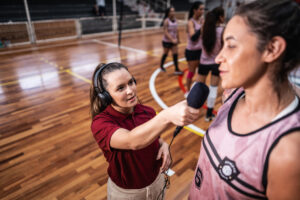Impactful comms during Disability Pride Month
Communicators can help bridge both seen and unseen gaps.

This July marks Disability Pride Month, a great reminder that inclusive, accessible comms help employees feel seen no matter what circumstances impact the way they work. But this takes some nuance, as not all disabilities are visible, and communicating about them with care and tact takes a compassionate listening ear.
We spoke with Dr. Nicole Price, founder, and CEO of Lively Paradox, who shared some strategies for comms pros to tell stories of differently abled employees and their achievements.
Resetting your understanding through dialogue
When you think of the word disability, there’s a good chance it might have a narrow definition. One of the first steps to understanding disabilities and championing those who have them is reflecting on how you understand them.
“When you use the word disability, most people have an image that immediately comes to mind,” Price said. She added that the image might be of a person on crutches or in a wheelchair, but there are more disabilities than meet the eye that communicators need to be aware of when crafting messaging. The key to that understanding lies in asking just what disability means for different demographics.
“They can give you the breadth and range of just what disabled means for them,” she said. “I might not know you have a visual impairment if you didn’t tell me beforehand. But if I know that, I can put captions on calls or other accessibility measures for you.”
Price added that dialogue can help build empathy and understanding, making content more accessible and inclusive for everyone.
“That can really help the way we engage with our people,” she said. “It’s all about awareness — it’s more difficult to be empathetic about things which you’re not fully aware of.”
Leadership should take ‘empathy walks’
When it comes to communications around disabilities or further accessibility for employees that are differently abled, it’s important that leaders need to have an acute knowledge of how disabilities are being communicated about and accounted for. Price recommends leaders take “empathy walks”, observing the day-to-day jobs and lives of employees with disabilities to shed light on where improvements in communications are needed. She shared examples of leaders and employees at a given organization sitting in a wheelchair for a day and realizing that the cut of their clothes didn’t fit right when seated. This helped them gain a newfound sense of empathy be recognizing the little things that others go through. In turn, it helped those leaders and employees refine how way they communicate.
Leaders can also gain more empathy and pass it along by reading material written from the perspective of disabled writers. This can help the comms team remove any inadvertent ableist language that might be present in their storytelling efforts.
“We used to use the term “blind spot” all the time to mean a lack of awareness,” remembers Price. “When people with visual impairments told us this was ableist language, we had to go back to the drawing board and think about what different words to use. We worked to scrub our materials, and now we just use terms like lacking in awareness or we say we’re ignorant of a certain topic.
Providing material support
It’s one thing to reconsider the way we think about our communications around disabilities and accessibility, and another to put those changes into practice. For Price, the biggest key is to widen the scope of how we communicate about diversity to include those with different abilities.
“When we think about diversity, we often just consider gender and race,” she said. “But what if we thought more broadly about that?”
Price mentioned of curb cuts, dips in the sidewalk that allow wheelchair users to cross the street more easily, as an example of an innovation that was made to accommodate those with differing abilities but is used by everyone.
“If you design for the neediest, it helps everyone,” she said. “Too often organizations design for the masses and leave out those on the fringes.”
Organizations who make these accommodations and tell stories about them aren’t just doing the right thing morally, but enhancing their employer brand, too.
“It may sound like majoring in the minutiae, but these things help people feel like they belong in the place they work,” said Price. “When you make these accommodations and foster a sense of belonging, you can both bolster the bottom line of the business and deepen inclusion as well.”







